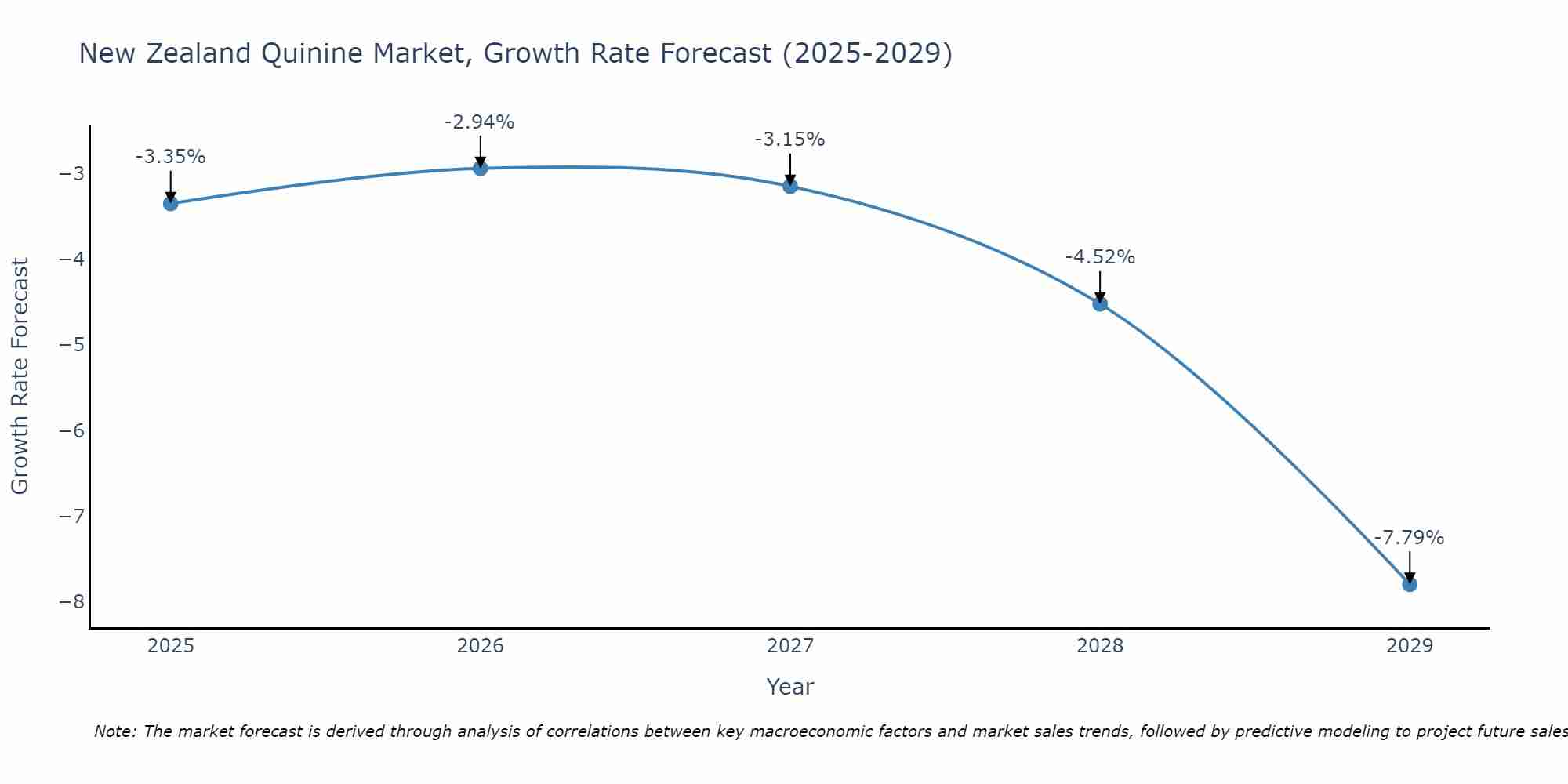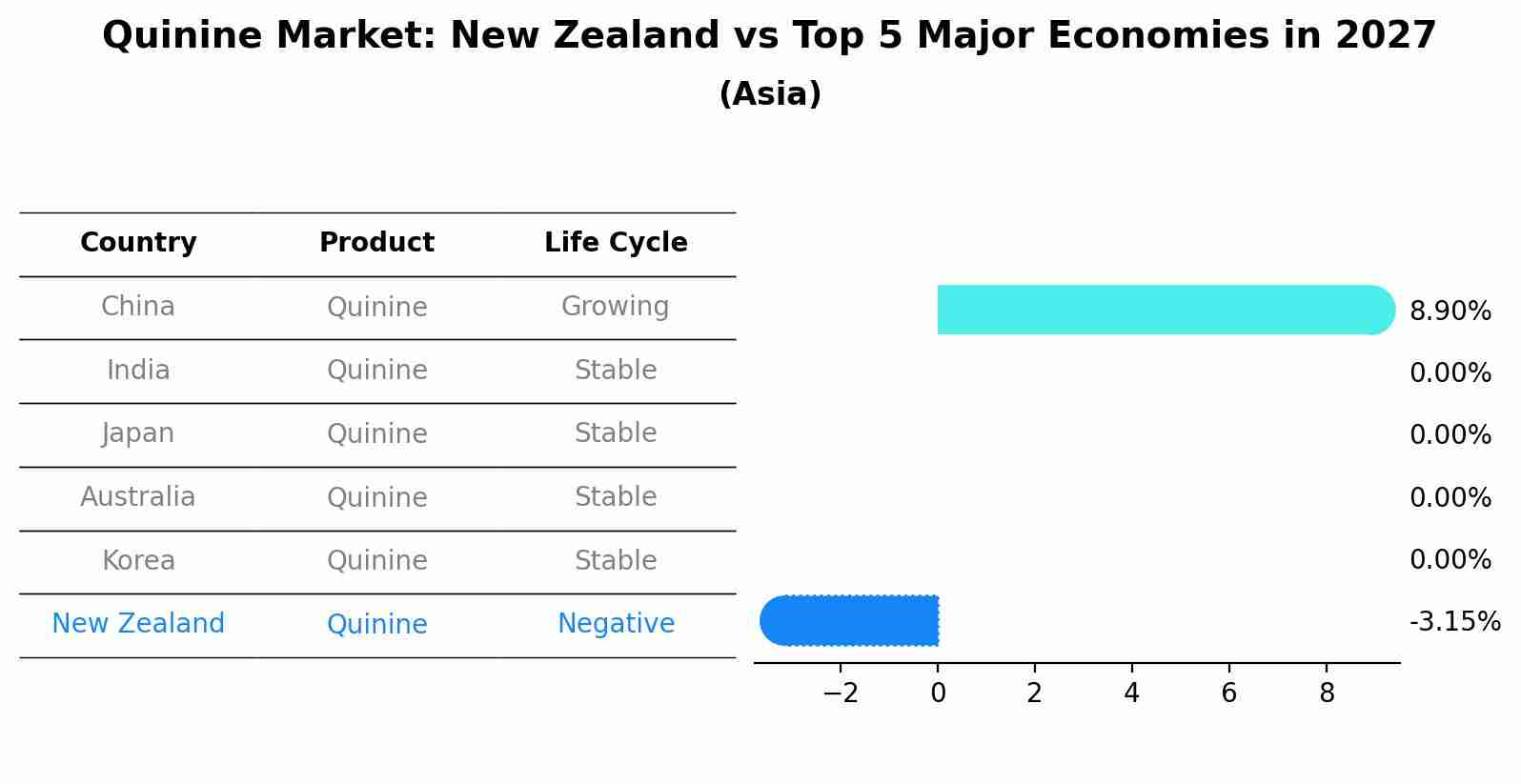New Zealand Quinine Market (2025-2031) | Share, Outlook, Trends, Segmentation, Size, Growth, Forecast, Companies, Value, Analysis, Industry & Revenue
| Product Code: ETC5312497 | Publication Date: Nov 2023 | Updated Date: Aug 2025 | Product Type: Market Research Report | |
| Publisher: 6Wresearch | Author: Bhawna Singh | No. of Pages: 60 | No. of Figures: 30 | No. of Tables: 5 |
New Zealand Quinine Market Size Growth Rate
The New Zealand Quinine Market is projected to witness mixed growth rate patterns during 2025 to 2029. Growth accelerates to -2.94% in 2026, following an initial rate of -3.35%, before easing to -7.79% at the end of the period.

Quinine Market: New Zealand vs Top 5 Major Economies in 2027 (Asia)
By 2027, the Quinine market in New Zealand is anticipated to reach a growth rate of -3.15%, as part of an increasingly competitive Asia region, where China remains at the forefront, supported by India, Japan, Australia and South Korea, driving innovations and market adoption across sectors.

New Zealand Quinine Market Overview
Quinine, derived from the bark of the cinchona tree, is known for its antimalarial properties and is also used in the production of tonic water. In New Zealand, the quinine market serves pharmaceutical companies, beverage manufacturers, and research institutions involved in drug development and natural products extraction. Market dynamics include fluctuations in quinine supply, regulatory considerations, and research on alternative antimalarial treatments.
Drivers of the market
The quinine market in New Zealand is driven by its applications in pharmaceuticals, particularly in the treatment of malaria. The demand for antimalarial drugs remains a primary driver. Additionally, quinine`s use in beverages, notably tonic water, contributes to market growth. Regulatory support and ongoing research into quinine`s medicinal properties also play a role.
Challenges of the market
The rabies vaccine market in New Zealand encounters challenges in terms of vaccine accessibility and public health awareness. Despite the importance of vaccination, ensuring widespread access and addressing vaccine hesitancy remain significant issues. Regulatory hurdles and maintaining cold chain logistics for vaccine distribution also pose challenges.
Government Policy of the market
Regulations in the quinine market ensure product safety and quality for medicinal and industrial uses. The government oversees standards for quinine production, labeling, and distribution to safeguard public health.
Key Highlights of the Report:
- New Zealand Quinine Market Outlook
- Market Size of New Zealand Quinine Market, 2024
- Forecast of New Zealand Quinine Market, 2031
- Historical Data and Forecast of New Zealand Quinine Revenues & Volume for the Period 2021-2031
- New Zealand Quinine Market Trend Evolution
- New Zealand Quinine Market Drivers and Challenges
- New Zealand Quinine Price Trends
- New Zealand Quinine Porter`s Five Forces
- New Zealand Quinine Industry Life Cycle
- Historical Data and Forecast of New Zealand Quinine Market Revenues & Volume By Mode of Administration for the Period 2021-2031
- Historical Data and Forecast of New Zealand Quinine Market Revenues & Volume By Oral Administration for the Period 2021-2031
- Historical Data and Forecast of New Zealand Quinine Market Revenues & Volume By Intravenous Administration for the Period 2021-2031
- Historical Data and Forecast of New Zealand Quinine Market Revenues & Volume By Intramuscular Administration for the Period 2021-2031
- Historical Data and Forecast of New Zealand Quinine Market Revenues & Volume By Others for the Period 2021-2031
- Historical Data and Forecast of New Zealand Quinine Market Revenues & Volume By Application for the Period 2021-2031
- Historical Data and Forecast of New Zealand Quinine Market Revenues & Volume By Antimalarial for the Period 2021-2031
- Historical Data and Forecast of New Zealand Quinine Market Revenues & Volume By Antipyretic for the Period 2021-2031
- Historical Data and Forecast of New Zealand Quinine Market Revenues & Volume By Others for the Period 2021-2031
- Historical Data and Forecast of New Zealand Quinine Market Revenues & Volume By End-user for the Period 2021-2031
- Historical Data and Forecast of New Zealand Quinine Market Revenues & Volume By Hospitals for the Period 2021-2031
- Historical Data and Forecast of New Zealand Quinine Market Revenues & Volume By Clinics for the Period 2021-2031
- Historical Data and Forecast of New Zealand Quinine Market Revenues & Volume By Ambulatory Surgical Centers for the Period 2021-2031
- Historical Data and Forecast of New Zealand Quinine Market Revenues & Volume By Others for the Period 2021-2031
- New Zealand Quinine Import Export Trade Statistics
- Market Opportunity Assessment By Mode of Administration
- Market Opportunity Assessment By Application
- Market Opportunity Assessment By End-user
- New Zealand Quinine Top Companies Market Share
- New Zealand Quinine Competitive Benchmarking By Technical and Operational Parameters
- New Zealand Quinine Company Profiles
- New Zealand Quinine Key Strategic Recommendations
Frequently Asked Questions About the Market Study (FAQs):
1 Executive Summary |
2 Introduction |
2.1 Key Highlights of the Report |
2.2 Report Description |
2.3 Market Scope & Segmentation |
2.4 Research Methodology |
2.5 Assumptions |
3 New Zealand Quinine Market Overview |
3.1 New Zealand Country Macro Economic Indicators |
3.2 New Zealand Quinine Market Revenues & Volume, 2021 & 2031F |
3.3 New Zealand Quinine Market - Industry Life Cycle |
3.4 New Zealand Quinine Market - Porter's Five Forces |
3.5 New Zealand Quinine Market Revenues & Volume Share, By Mode of Administration, 2021 & 2031F |
3.6 New Zealand Quinine Market Revenues & Volume Share, By Application, 2021 & 2031F |
3.7 New Zealand Quinine Market Revenues & Volume Share, By End-user, 2021 & 2031F |
4 New Zealand Quinine Market Dynamics |
4.1 Impact Analysis |
4.2 Market Drivers |
4.2.1 Increasing awareness about the health benefits of quinine consumption |
4.2.2 Growing demand for natural and organic products in the market |
4.2.3 Rising prevalence of diseases like malaria and leg cramps, for which quinine is used as a treatment |
4.3 Market Restraints |
4.3.1 Stringent regulations on quinine production and distribution |
4.3.2 Fluctuations in raw material prices affecting the overall production cost |
4.3.3 Competition from alternative treatments and substitutes in the market |
5 New Zealand Quinine Market Trends |
6 New Zealand Quinine Market Segmentations |
6.1 New Zealand Quinine Market, By Mode of Administration |
6.1.1 Overview and Analysis |
6.1.2 New Zealand Quinine Market Revenues & Volume, By Oral Administration, 2021-2031F |
6.1.3 New Zealand Quinine Market Revenues & Volume, By Intravenous Administration, 2021-2031F |
6.1.4 New Zealand Quinine Market Revenues & Volume, By Intramuscular Administration, 2021-2031F |
6.1.5 New Zealand Quinine Market Revenues & Volume, By Others, 2021-2031F |
6.2 New Zealand Quinine Market, By Application |
6.2.1 Overview and Analysis |
6.2.2 New Zealand Quinine Market Revenues & Volume, By Antimalarial, 2021-2031F |
6.2.3 New Zealand Quinine Market Revenues & Volume, By Antipyretic, 2021-2031F |
6.2.4 New Zealand Quinine Market Revenues & Volume, By Others, 2021-2031F |
6.3 New Zealand Quinine Market, By End-user |
6.3.1 Overview and Analysis |
6.3.2 New Zealand Quinine Market Revenues & Volume, By Hospitals, 2021-2031F |
6.3.3 New Zealand Quinine Market Revenues & Volume, By Clinics, 2021-2031F |
6.3.4 New Zealand Quinine Market Revenues & Volume, By Ambulatory Surgical Centers, 2021-2031F |
6.3.5 New Zealand Quinine Market Revenues & Volume, By Others, 2021-2031F |
7 New Zealand Quinine Market Import-Export Trade Statistics |
7.1 New Zealand Quinine Market Export to Major Countries |
7.2 New Zealand Quinine Market Imports from Major Countries |
8 New Zealand Quinine Market Key Performance Indicators |
8.1 Number of health and wellness campaigns promoting quinine consumption |
8.2 Percentage of consumers preferring natural and organic quinine products |
8.3 Number of reported cases of diseases where quinine is prescribed |
8.4 Research and development investment in quinine-based products |
8.5 Consumer satisfaction and perception surveys on quinine products |
9 New Zealand Quinine Market - Opportunity Assessment |
9.1 New Zealand Quinine Market Opportunity Assessment, By Mode of Administration, 2021 & 2031F |
9.2 New Zealand Quinine Market Opportunity Assessment, By Application, 2021 & 2031F |
9.3 New Zealand Quinine Market Opportunity Assessment, By End-user, 2021 & 2031F |
10 New Zealand Quinine Market - Competitive Landscape |
10.1 New Zealand Quinine Market Revenue Share, By Companies, 2024 |
10.2 New Zealand Quinine Market Competitive Benchmarking, By Operating and Technical Parameters |
11 Company Profiles |
12 Recommendations | 13 Disclaimer |
- Single User License$ 1,995
- Department License$ 2,400
- Site License$ 3,120
- Global License$ 3,795
Search
Thought Leadership and Analyst Meet
Our Clients
Related Reports
- Afghanistan Apparel Market (2026-2032) | Growth, Outlook, Industry, Segmentation, Forecast, Size, Companies, Trends, Value, Share, Analysis & Revenue
- Canada Oil and Gas Market (2026-2032) | Share, Segmentation, Value, Industry, Trends, Forecast, Analysis, Size & Revenue, Growth, Competitive Landscape, Outlook, Companies
- Germany Breakfast Food Market (2026-2032) | Industry, Share, Growth, Size, Companies, Value, Analysis, Revenue, Trends, Forecast & Outlook
- Australia Briquette Market (2025-2031) | Growth, Size, Revenue, Forecast, Analysis, Trends, Value, Share, Industry & Companies
- Vietnam System Integrator Market (2025-2031) | Size, Companies, Analysis, Industry, Value, Forecast, Growth, Trends, Revenue & Share
- ASEAN and Thailand Brain Health Supplements Market (2025-2031) | Strategy, Consumer Insights, Analysis, Investment Trends, Opportunities, Growth, Size, Share, Industry, Revenue, Segments, Value, Segmentation, Supply, Forecast, Restraints, Outlook, Competition, Drivers, Trends, Demand, Pricing Analysis, Competitive, Strategic Insights, Companies, Challenges
- ASEAN Bearings Market (2025-2031) | Strategy, Consumer Insights, Analysis, Investment Trends, Opportunities, Growth, Size, Share, Industry, Revenue, Segments, Value, Segmentation, Supply, Forecast, Restraints, Outlook, Competition, Drivers, Trends, Demand, Pricing Analysis, Competitive, Strategic Insights, Companies, Challenges
- Europe Flooring Market (2025-2031) | Outlook, Share, Industry, Trends, Forecast, Companies, Revenue, Size, Analysis, Growth & Value
- Saudi Arabia Manlift Market (2025-2031) | Outlook, Size, Growth, Trends, Companies, Industry, Revenue, Value, Share, Forecast & Analysis
- Uganda Excavator, Crane, and Wheel Loaders Market (2025-2031) | Strategy, Consumer Insights, Analysis, Investment Trends, Opportunities, Growth, Size, Share, Industry, Revenue, Segments, Value, Segmentation, Supply, Forecast, Restraints, Outlook, Competition, Drivers, Trends, Demand, Pricing Analysis, Competitive, Strategic Insights, Companies, Challenges
Industry Events and Analyst Meet
Whitepaper
- Middle East & Africa Commercial Security Market Click here to view more.
- Middle East & Africa Fire Safety Systems & Equipment Market Click here to view more.
- GCC Drone Market Click here to view more.
- Middle East Lighting Fixture Market Click here to view more.
- GCC Physical & Perimeter Security Market Click here to view more.
6WResearch In News
- Doha a strategic location for EV manufacturing hub: IPA Qatar
- Demand for luxury TVs surging in the GCC, says Samsung
- Empowering Growth: The Thriving Journey of Bangladesh’s Cable Industry
- Demand for luxury TVs surging in the GCC, says Samsung
- Video call with a traditional healer? Once unthinkable, it’s now common in South Africa
- Intelligent Buildings To Smooth GCC’s Path To Net Zero


















